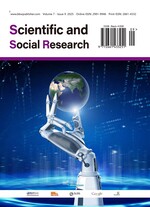Exploration of Innovative Paths for Disability- Assistance Social Work in the Context of New Productive Forces
Abstract
Today, the application scenarios of the Internet and information technology in the construction of barrier-free environments are constantly expanding. Aging-friendly smart devices bring high-quality life experiences to many elderly people. Barrier-free urban governance systems use intelligent hardware and software to provide more convenient and inclusive services for people in need. Visually and hearing-impaired users watching movies and listening to music on mobile phones have also become a reality from imagination. Technology is changing people’s lifestyles, promoting the transformation of social disability-assistance work from hardware to intelligence and digitization. While helping people with disabilities access information, it also draws them back into social life, striving to practice the social development goal of “no one left behind.”
References
Cheng K, 2024, Improving the Social Security System and Care Service System for Disabled Persons in the Process of Chinese-Style Modernization. Disability Research, 2024(4): 3–12.
Zhang WH, Zhao JX, 2023, Development of the Cause of Disabled Persons in the Context of Chinese-Style Modernization. Disability Research, 2023(1): 11–20.
Huang TT, 2024, Analysis of the Role Orientation of Social Workers in Intervening in Grassroots Community Governance. China Social Work, 2024(15): 12–18.
Zhou W, Xu LY, 2023, On New Productive Forces: Connotation, Characteristics and Key Focuses. Reform, 2023(10): 1–13.
Qi YD, Shen TY, 2024, Artificial Intelligence Empowering New Productive Forces: Logic, Models and Paths. Research on Economics and Management, 2024(7): 3–17.
Wang QM, Yang JE, 2023, Digital New Productive Forces and High-Quality Development of China’s Agriculture. Journal of Shaanxi Normal University (Philosophy and Social Sciences Edition), 2023(6): 61–72.
Zhang P, Nan XG, 2024, Companion and Coupling: High-Quality Development of Vocational Education from the Perspective of New Productive Forces. College Education Management, 2024(3): 44–52.
Wang M, Xie YP, Chen PQ, 2024, Market Segmentation, Innovation Spatial Correlation and Industrial Structure Transformation and Upgrading. Frontier of Engineering Management Science, 2024(9): 1–12.
Mao XZ, Li SW, 2014, Ethical Dilemmas and Solutions of Disability Social Work in China. Journal of Wuhan University of Technology (Social Sciences Edition), 2014(5): 741–746.
Jiao Y, Qi MX, 2024, Digital Economy Empowering the Development of New Productive Forces. Economic and Management Review, 2024(3): 17–30.
Zhang X, Yu MM, 2024, “Narration” and “Discussion” of New Productive Forces: Era Significance, Practical Paths and Chinese-Style Modernization. Journal of Hebei University of Economics and Business, 2024(4): 1–9.
Ren YH, 2024, Theoretical Contributions and Practical Significance of the Proposal of New Productive Forces. Hunan Social Sciences, 2024(4): 44–50.
Han F, Jin QH, Guo GS, 2024, Vocational Education and New Productive Forces: Two-Way Empowerment from the Perspective of Innovation Ecosystem Theory. Higher Education Exploration, 2024(3): 58–64.
Zhang YP, Ren JK, Yan F, et al., 2024, Construction of “Internet +” Continuous Rehabilitation Training Comprehensive Intervention Model and Its Empirical Research in Depressive Patients. China Journal of Health Psychology, 2024(6): 818–824.
Su Q, Luo JY, Qiu XY, et al., 2024, Coupling Logic and Practical Path of New Productive Forces and Scientific and Technological Talent Cultivation. Modern Information, 2024(9): 1–12.

